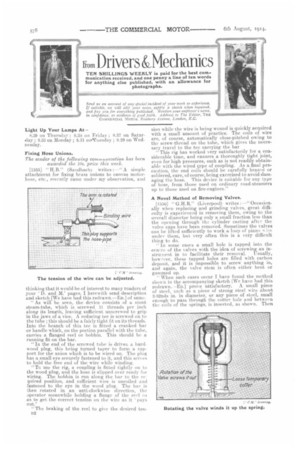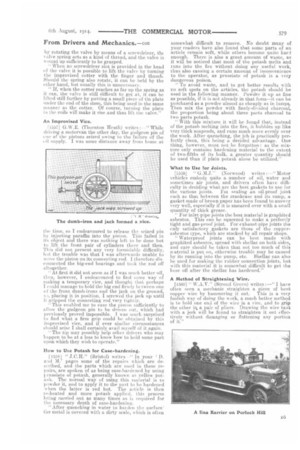Ea m Drivers &Mechanics
Page 22

Page 23

If you've noticed an error in this article please click here to report it so we can fix it.
TEN SHILLINGS WEEKLY is paid for the best cornmunication received, and one penny a line of ten words for anything else published, with an allowance for photographs.
Send us an account of any sPecial incident of your work or experience. If suitable, we will edit your notes, supfily a sketch when required, and pay you for everything published. Mention your employer's name, in confidence, as evidence of good faith. Address to The Editor, THE COMMERCIAL MOTOR. Roscbcry Avenue, London, E.G.
Light Up Your Lamps At 8.39 on Thursday .; 8.St on Friday ; 8.37 on Saturday; 8.33 on Monday ; 8.31 oniVuesday ; 8.29 on Wednesday.
Fixing Hose Unions.
The sender of the following communication has been awarded the Ms. prize this week.
[1555] " B." (Sandbach) writes :—" A simple attachment for fixing brass unions to canvas motorhose, etc., recently came under my observation, and
-thinking that it would be of interest to many readers of your IX and M.' pages. I herewith send description and :sketch [We have had this redrawn.—ED.] of same.
" As will be seen, the device consists of a stout steam-tube, which is screwed 11 threads per inch along its length, leaving sufficient unscrewed to grip in the jaws of a. vice. A reducing tee is screwed on to the tube ; this should be a fairly tight fit on its threads. Into the branch of this tee is fitted a cranked bar or handle which, on the portion parallel with the tube, carries a flanged reel or bobbin. This should be a running fit on the bar. "In the end of the screwed tube is driveli a hardwood plug, this being turned taper to form a support for the union which is to be wired on. The plug has a. small eye securely fastened to it, and this seie ie to hold the free end of the wire while winding. "To use the rig, a coupling is fitted tightly on to the wood plug, and the hose is slipped over ready for wiring. The bobbin is run along the bar to the required position, and sufficient wire is uncoiled and fastened to the eye in the wood plug. The bar is then rotated in an anti-clockwise direction, the operator meanwhile holding a flange of the reel so as to get the correct. tension on the wire as it pays -out.'
"The braking of the reel to give the desired tenD2 sion while the wire is being wound is quickly acquired with a small amount of practice. The coils of wire are, of course, automatically close-pitched owing to the screw-thread on the tube, which gives the necessary travel to the tee carrying the bar
'This rig has worked very satisfactorily for a considerable time, and ensures athoroughly tight joint, even for high pressures, such as is not readily obtainable with the wired type of coupling. As a. final precaution, the end coils should be carefully brazed or soldered, care, of course, being exercised to avoid damaging the hose. This device is suitable for any type of hose, from those used on ordinary road-steamers up to those used on fire-engines."
A Novel Method of Removing Valves.
[1556] " G.H. R." (Liverpool) writes : —" Occasionally when replacing and grinding valves, great difficulty is experienced in removing them, owing to the overall diameter being only a small fraction less than the opening through the cylinder casting after the valve caps have been removed. Sometimes the valves can he lifted sufficiently to work a loop of piano e ire under them, but very often this is a. very difficult thing to do. "In some cases a small hole is tapped into the cenere of the valves with theidea of screwing an in strueneet in to facilitate their removal. Usually, however, these tapped holes are filled with carbon deposit, and it is impossible to screw anything in, and again, the valve stem is often either bent or gummed up.
"When such cases occur I have found the method shown in the accompanying sketch [We have had this redrawn. —ED.] prove satisfactory. A small piece of steel, such as a piece of strong steel wire about 3-32nds in. in diameter, or any piece of steel, small enough to pass through the cotter hole and between the coils of the springs, is inserted, as shown. Then
by rotating the valve by means of a screwdriver, tht valve spring acts as a kind of thread, and the valve is wound up sufficiently to be grasped. •• When no screwdriver slot is provided in the head of the valve it is possible to lift the valve by turning the improvised cotter with the finger and thumb. Should the spring also rotate, it can be held by the other hand, but usually this is unnecessary.
" If, when the cotter reaches as far up the spring as it can, the valve is still difficult to get at, it can be lifted still further by putting a small piece of tin plate under the end of the stem, this being used in the same manner as the cotter. Of course, turning the plate in the coils will make it rise and thus lift the valve."
An Improvised Vice.
1i557] G.W.E. (Thornton Heath) writes •" While driving a motorvan the other day, the gudgeon pin of vile of the pistons seized owing to the failure of the oil supply. I was some distance away from home at
L C &t. Thedrawiard The dumb-iron and jack formed a vice. the time, so I endeavoured to release the seized pin by injecting paraffin into the piston. This failed in its object and there was nothing loft to be done but to lift the front pair of cylinders there and then. This did not present any very formidable difficulty, but the trouble was that I was afterwards unable to move the piston on its connecting rod. I therefore dis. connected the big-end bearings and took the rod off altogether.
" At first it did not seem as if I was much better olf, then, however, I endeavoured to find some way of making a temporary vice, and thought that perhaps I could manage to hold the big end finely between one of the front dumb-irons and the jack on the ground, Si, placing it in position, I screwed the jack up until it gripped the connecting rod very tightly.. " This enabled rue to ease the piston sufficiently to allow the gudgeon pin to be driven out, which had previously proved impossible. I was nmeh surprised lo find what a firm grin could he obtained by this improvised vice, and if ever similar circumstances should arise I shall certainly avail myself of it again.
" The tip may possibly help other drivers who may happen to be. at a loss to know how to hold some part upon which they wish to operate!'
How to Use Potash for Case-hardening.
[155S.1 " J.C.H." (Bristol) writes ---" In your
nod M.' pages some of the repairs which are described, and -the parts which are used in these repairs, are spoken of as being case-hardened by using prussiate ot potash, generally known as yellow potash. The normal way of using this material is to powder it, and to apply it to the part to be hardened when the latter is red hot. The article is then re-heated and more potash applied, this process -1)6ng carried out as many times as is required for the necessary depth of case-hardening. " After quenching in water to harden the surface the metal is covered with a dirty scale, which is often
somewhat difficult to remove. No doubt many of your readers have also found that some parts of an artiele remain soft, while others become quite hard enough. There is also a great amount of waste, as it will be noticed that most of the potash melts and iuns into the fire without doing any useful work, thus also causing a certain amount of inconvenience to the operator, as puissiate of potash is a very dangerous poison.
" To avoid waste, and to get better results with no soft spots on the articles, the potash should be used in the following manner. Powder it up as fine as possible, if it is not already in that form—it can be purchased as a powder almost as cheaply as in lumps. Then mix the powder with finely-divided charcoal, the proportion being about three parts charcoal to two parts potash.
" With this mixture it will be found that, instead of the potash melting into the fire, it bubbles up like very thick soapsuds, and runs much more evenly over the work. After quenching, the job is practically perfectly clean, this being a decided advantage. One thing, however,. must not be forgotten : as the mixture only contains hardening material to the extent of two-fifths of its bulk, a greater quantity should be used than if plain potash alone be utilized."
What to Use for Joints.
[1539J " (Norwood) writes :—" Motor vehicles embody quite a number of oil, water and sometimes air joints, and drivers often have difficulty in deciding what are the best gaskets to use for the various joints. For scaling an oil-proof joint such as that between the ,crankcase and its sump, a gasket made of brown paper has been found to answer very well, especially if it is smeared over with a small quantity of thick grease. " For inlet-pipe joints the best material is graphited asbestos. This can be. squeezed to make a perfectly tight and gas-proof joint. For exhaust-pipe joints the only satisfactory gaskets are those of the copperasbestos type, which are stocked by all repair shops.
." Waterproof joints can be best made with graphited asbestos, spread with shellac on both sides, and care should be taken that not too much of this material is put on, otherwise trouble may be caused by its running into the pump, etc. Shellac can also be used for making the rubber connection joints, but with this material it is somewhat difficult to get the hose off after the shellac ha-s hardened."
A Method of Straightening Wire., 05601 "W.A.V." (Stroud Green) writes :—" I have often seen a mechanic straighten a piece of bent copper wire by hammering it out. This is atvheory th foolish way or doing e work, a much better me d is to hold one end of the wire in a vice. and to grip the other in, a pair of pliers. Drawing the wire taut with a jerk will be found to straighten it ont effectively without damaging or flattening any portion of it."
























